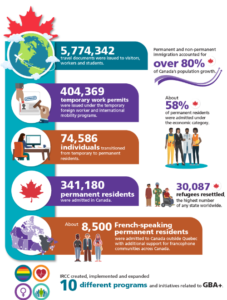Positive signal to international students as Canada sets immigration targets
Canada continues to be a top destination for international students, and a place for many to build their futures. According to the 2021-2023 Immigration Levels Plan released by the IRCC, Canada hopes to welcome 1,233,000 permanent residents to Canada by the end of 2023.
In his annual report, the Minister of Immigration, Refugees, and Citizenship states: “Canada continues to be a safe and welcoming destination for immigrants, refugees and asylum seekers […] Even as we adjust to the extraordinary challenge of the COVID-19 pandemic, we cannot lose sight of the enormous benefits immigration presents to our prosperity and way of life.”
The Canadian government has announced plans to welcome some 1,233,000 new permanent residents into the country between 2021 and 2023, something that Universities Canada says will be a “positive signal” to international students.
The targets were published by Immigration Refugees and Citizenship Canada following the tabling of the 2020 Annual Report to Parliament on Immigration.
In the report, minister of Immigration, Refugees and Citizenship Marco Mendicino said that immigrants enrich Canada “beyond measure”, and no accounting of the country’s progress over the last century and a half is complete without including the contributions of newcomers.
Canada now aims to welcome 401,000 new permanent residents in 2021, 411,000 in 2022, and 421,000 in 2023 – a goal which stakeholders have said will be partly achieved by international students remaining in the country after their studies.
“These newly announced immigration targets are a positive signal to international students that Canada is eager to welcome skilled talent from around the world,” Wendy Therrien, director of research and external relations at Universities Canada, told The PIE News.
“Graduates of Canadian Citizenship can benefit from clear government pathways to immigration if they wish to stay in Canada after their studies,” she said.
Cosmina Morariu, senior manager of Fragomen, a leading law firm that deals with immigration services, explained that a study permit is one of the main gates into Canada.
“It allows you to come and study and then after you finish your studies you can get a post-graduate work permit, which is an open, very flexible permit that allows you to work for any employer, at any location in Canada.
“The maximum duration you can get on that permit is three years, so it is very convenient. The moment you have one year of employment in Canada you can apply for permanent residence,” she told The PIE.
Morariu explained that students who applied for permanent residence after completing one year on a post graduate work permit would make up a significant part of the IRCC’s targets.
Watch the Below video for Everything you need to know about Canada’s Immigration Levels Plan 2021-2023:
Data provided by IRCC gives a breakdown of which categories of immigrants the country hopes to welcome.
The highest group is economic immigrants – with targets currently being set at bringing 723,500 of this group into the country between 2021 and 2023.
The economic immigrant group is further broken down into six sections including,
- Federal High Skilled,
- Federal Business,
- Economic Pilots: Caregivers; Agri-Food Pilot;
- Rural and Northern Immigration Pilot,
- Atlantic Immigration Pilot Program,
- Provincial Nominee Program and Quebec Skilled Workers and Business.

“When you look at the breakdown of the levels, it doesn’t specifically say that it is for students. But normally students will fall under the economic class, so for example the federal high skilled stream will include the Canadian experience class candidates.” said Morariu.
“So within those admissions for the federal high skilled […] a proportion of that, if not the majority will be Canadian experience class, which comes from the student population.”
International students are likely to play a significant role in the government achieving its immigration targets between 2021 and 2023.
Morariu said that the government’s plans to welcome so many permanent residents is “ambitious”, but “doable if you are targeting students”.
“Is Canada attractive to international students? Yes. If you look at the numbers, and the Canadian government has a website where it publishes the number of applications that it receives for students, workers, permanent residents and how many were adjudicated, you see that last year alone there were over 400,000 applications for students.
“The majority of the students are from India, China, Brazil, Korea, Vietnam, and now with an increase from the US as well. The numbers are a bit lower for 2020, but looking back at 2015, they almost doubled up until 2019.”
“I think we are going to see more people applying for study permits, because it is very easy to get your foot in the door and apply for permanent residence,” she added.
Sonja Knutson, director, internationalization office interim at the Memorial University of Newfoundland, said that Canada’s international education strategy has been successful largely because of the country’s reputation for straightforward immigration pathways, openness to diverse cultures and recognition that adjusting to new demography is a “two-way street”.
“So while the immigration announcement does not yet provide detail about direct impacts on international students, we do believe the news will help international student recruitment since students and their parents continue to see Canada as a safe and welcoming place,” she said.
Positive signal to int’l students as Canada sets immigration targets
Watch this video for Everything you need to know about Canada’s Immigration Levels Plan 2021-2023:
